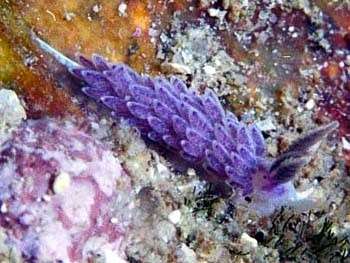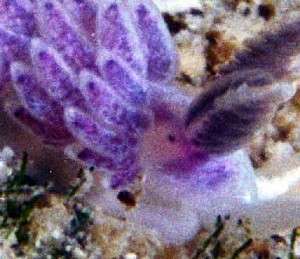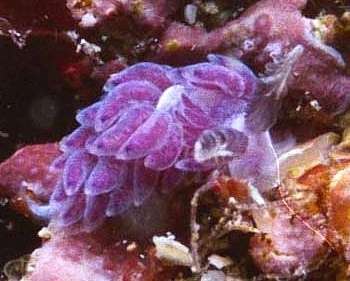
Favorinus perfoliatus
Baba, 1949
Order: NUDIBRANCHIA
Suborder: AEOLIDINA
Family: Glaucidae
DISTRIBUTION
Known only from Japan
PHOTO
Mie, Shima Pref. Japan (Kii Peninsula east coast). Depth: 3 m. Length: 5 mm. Jan. 2000. Photo: Yasuhiro Shirai
Known only from the original description:
'Length about 6mm. With perfoliated rhinophores which are quite unusual in the genus Favorinus. Cephalic tentacles as usual. Fusiform [cerata] in 6-7 groups on either side, about 9 in first, 7 in second, 4 in third, 3 in fourth and 2-1 in last groups, the foremost 2 groups standing on horseshoes, the rest forming mere onbique rows. ..... Foot corners tentaculiform. Body pale rose, the [cerata] veined with rose-red, the rhinophores dark. masticatory edge of jaw-plates as in preceding species. Radula formula 18 x 0.1.0. median cusp of the central tooth smooth or with less than 5 denticles. Loc: Amekisho, Sagami Bay, 16-20 m (July 1936 & August 1940, 3 sps.)'
The only character of much value is the perfoliate shape of the rhinophores. The colour of the cerata is often dependent on the colour of the most recent eggs the animals have eaten, and the only other colour information - rhinophores dark - could mean black or perhaps dark pink. At the suggestion of Atsushi Ono, I have tentatively identified a perfoliate species from Japan, with black perfoliate [lamellate] rhinophores, as F. perfoliatus.
-
Baba, K. (1949) Opisthobranchia of Sagami Bay collected by His Majesty The Emperor of Japan. Iwanami Shoten, Tokyo. 194 pp., 50 Pls.
Rudman, W.B., 2005 (April 29) Favorinus perfoliatus Baba, 1949. [In] Sea Slug Forum. Australian Museum, Sydney. Available from http://www.seaslugforum.net/find/favoperf
Related messages
Yasuhiro's Favorinus mirabilis
April 30, 2005
From: Atsushi Ono
Dear Bill,
Concerning Yasuhiro Shirai's photograph [message #2108]. This aeolid has the possibility that it is Favorinus perfoliatus Baba, 1949. The shape of rhinophores are peculiar apparently unique among the species of Favorinus described from Japan. It is possible the type specimen might help - the figure in Baba, 1949 is not very clear.
Sincerely,
Atsushi Ono
ononini@cosmos.ne.jp
Ono, A., 2005 (Apr 30) Yasuhiro's Favorinus mirabilis. [Message in] Sea Slug Forum. Australian Museum, Sydney. Available from http://www.seaslugforum.net/find/13442Dear Atsushi,
I agree that Baba's description of this species is not very useful. Certainly the 'perfoliate' rhinophores are unusual in the genus, and apparently different from those of F. mirabilis and F. tsuruganus. I am happy to follow your suggestion that we tentatively identify this animal as Baba's F. perfoliatus. One obvious need is to check the anatomy of a known specimen.
Best wishes,
Bill Rudman
Re: Antonietta? from Japan
March 18, 2000
From: Yasuhiro Shirai


Dear Bill,
Thank you for your reply about Antonietta?.
Here are 2 more image files for reference.
I sometimes see these animals. When I saw them they were the same color as the photos. I think this animal's cerata do not change like Favorinus mirabilis.
Best regards,
Yasuhiro Shirai
yasuhiro@e-net.or.jp
Shirai, Y., 2000 (Mar 18) Re: Antonietta? from Japan. [Message in] Sea Slug Forum. Australian Museum, Sydney. Available from http://www.seaslugforum.net/find/2108[Note added April 29 2005: See message #13442 suggesting this may be Favorinus perfoliatus]
Dear Yasuhiro,
Thanks for the extra photos. The only way to be sure of their identity would be to look at their anatomy. Having looked at the wide range of colour found in photos of Favorinus mirabilis on the Forum, I think it is quite possible that your animal is Favorinus mirabilis. At 5mm it is probably a juvenile and so may have not yet developed any of the 'adult' colour features such as white speckling on the cerata and a reddish mark in the anterior midline.
At this small size you would be unlikely to see any noticeable change in ceratal colour as both animals may have been feeding on their first egg mass.
Sorry I can't be more positive. Perhaps next time you find any, see if there is a purple egg mass nearby, or see if you can keep an animal alive on a different coloured egg mass and see firstly whether it eats eggs, which would suggest it is a Favorinus and if so, whether it changes colour on its new egg mass.
Best wishes,
Bill Rudman.
Antonietta? from Japan
February 17, 2000
From: Yasuhiro Shirai

Dear Bill,
Thank you for your reply to my last question. I found this opisthobranch at Shima. This opisthobranch crawled on rock with seaweed like my photo.
Could you please identify this animal for me.
Data:
Location: Shima Pref. Mie Japan (Kii Peninsula east coast)
Length: 5mm
Water temperature: 13C
Date Jan. 2000
Depth: 3m
Crawling on rock
Best regards,
Yasuhiro Shirai
yasuhiro@e-net.or.jp
Shirai, Y., 2000 (Feb 17) Antonietta? from Japan. [Message in] Sea Slug Forum. Australian Museum, Sydney. Available from http://www.seaslugforum.net/find/1895[Note added April 29 2005: See message #13442 suggesting this may be Favorinus perfoliatus]
Dear Yasuhiro,
I'm not sure of this one but I wonder if it is a colour form of Favorinus mirabilis. It has the dark spot on the cerata and black perfoliate rhinophores like that species but without an idea of its anatomy it could easily be something else.
Best wishes,
Bill Rudman.
